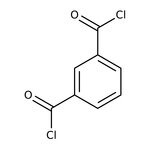Search Thermo Fisher Scientific
Dichlorure d’isophthaloyle, 98 %, Thermo Scientific Chemicals



Dichlorure d’isophthaloyle, 98 %, Thermo Scientific Chemicals
Identifiants chimiques
Spécifications
Description
This Thermo Scientific Chemicals brand product was originally part of the Alfa Aesar product portfolio. Some documentation and label information may refer to the legacy brand. The original Alfa Aesar product / item code or SKU reference has not changed as a part of the brand transition to Thermo Scientific Chemicals.
Le dichlorure d’isophthaloyle est utilisé dans une variété de polymères et de fibres de performance, où il a un impact sur la résistance aux flammes, la stabilité thermique, la résistance chimique et la flexibilité. En outre, il s’agit d’un stabilisateur efficace pour les prépolymères d’uréthane en raison de sa capacité à neutraliser l’eau. Également utilisé dans les matières premières en fibres aromatiques.
Solubilité
Réagit avec l’eau.
Remarques
Incompatible avec les bases fortes et les agents oxydants forts. Il est sensible à l’humidité. Stockez-le dans un endroit frais. Garder le récipient bien fermé dans un endroit sec et bien ventilé. Sensible à l’humidité.
Figures
Documentation et téléchargements
Certificats
Foire aux questions (FAQ)
Citations et références
Sécurité et manipulation
Classification of the substance or mixture
CLP classification - Regulation(EC) No 1272/2008
Label Elements
Signal Word
Danger
Hazard Statements
H312 - Harmful in contact with skin
H314 - Causes severe skin burns and eye damage
H331 - Toxic if inhaled
EU Specific Hazard Statements
EUH014 - Reacts violently with water
Precautionary Statements
P280 - Wear protective gloves/protective clothing/eye protection/face protection
P301 + P330 + P331 - IF SWALLOWED: Rinse mouth. Do NOT induce vomiting
P303 + P361 + P353 - IF ON SKIN (or hair): Take off immediately all contaminated clothing. Rinse skin with water or shower
P304 + P340 - IF INHALED: Remove person to fresh air and keep comfortable for breathing
P305 + P351 + P338 - IF IN EYES: Rinse cautiously with water for several minutes. Remove contact lenses, if present and easy to do. Continue rinsing
P310 - Immediately call a POISON CENTER or doctor/physician